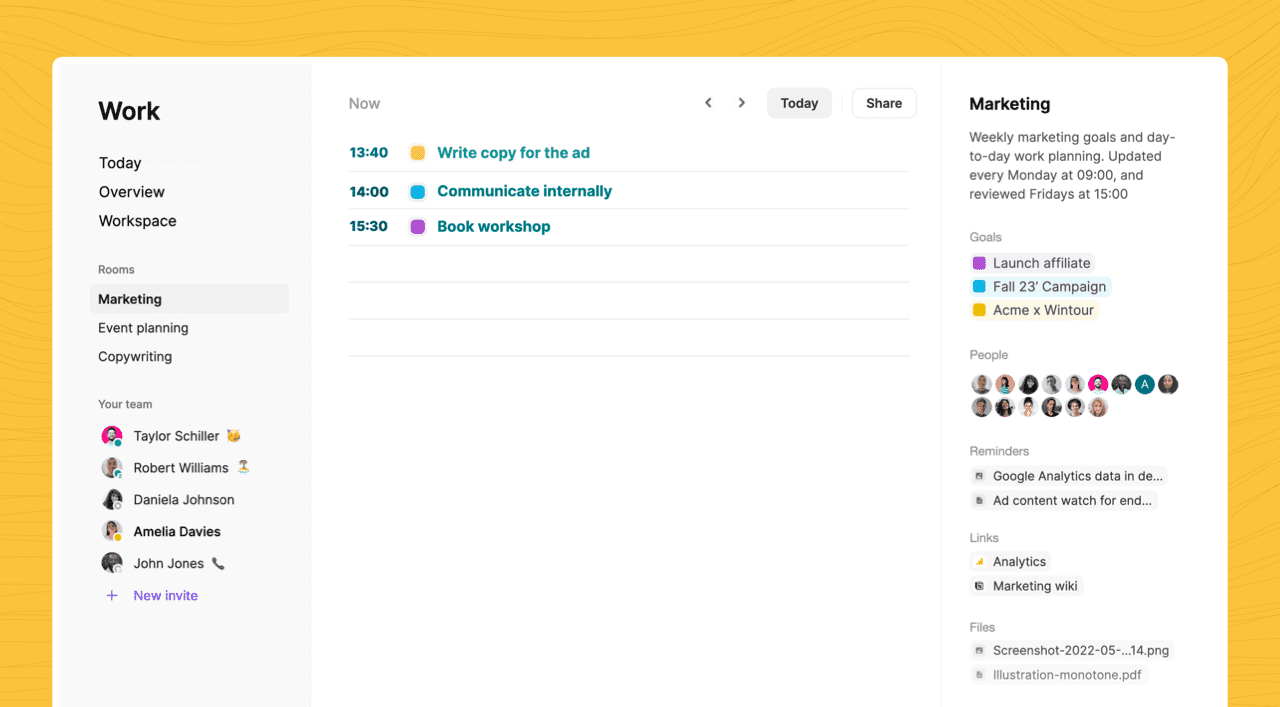Pembio
A curated collection of resources, worksheets and templates within the productivity space.
Get the app ✌️The best tips for setting team goals!
Most of today's firms use goals and analytics to at least some extent to guide their journey and inform them of the progress they’re making. The most crucial step to make sure the company moves closer to its long-term vision, is to set appropriate objectives to push performance.
The team members are expected to contribute to achieving the team's goals, which are essentially performance targets. The most effective team objectives are those that are co-created by the team members themselves, and that are connected with the purposes of the broader business.
Benefits of team goals
Setting team goals in partnership with your team has many benefits, not only for you as manager but also for the members of the team and the company as a whole.
The team members understand how their contributions fit within the context of the team when they have objectives to strive toward.
Your team will benefit from having a well-defined path and strategy if it has objectives to work toward.
Better responsibility and a sense of ownership may be achieved using team objectives.
Pursuing a team's objectives opens up the opportunity for building trust and collaboration.
The team members can advance their careers and acquire new skills directly from working toward the team's objectives.
Individual and collective growth may be evaluated using the framework the team's objectives provide.
The establishment of group objectives might be of assistance in determining whether priorities have been neglected or ignored.
The team's objectives help evaluate individual and group performance.
The contribution that a team makes to the overall company goals may be better understood thanks to the objectives that the team has set.

Ways to help your team by setting goals
1). Clarify your aims
Think about why you want to create objectives and how you plan to reach that point before sharing your thoughts with your team. What are the repercussions that will result from the accomplishment of the more expansive team goal?
What are the advantages that it will provide to your organization? Measurement is an essential component of goal-setting, so before you begin, plan how you will check in on your development during and after completing the task and how this will affect the outcomes you want to achieve.
2). Set group-wide goals
After deciding what you want to accomplish, the first step is to outline some objectives for the team. Teams can come together as a more productive and collaborative entity when they are working towards meaningful goals, particularly also if these goals are ambitious and requires a joint effort to reach.
As a result, rather than competing with one another, team members are better able to organize their efforts and concentrate on a unified goal. The team's objectives may (and should) be broken down further to individual level so that everyone knows what they personally have to do.
Write the goals down. Putting objectives down in writing significantly increases the likelihood that such goals will be attained. Getting colleagues involved in defining objectives for themselves and their group raises the prospect that they'll commit to reaching their targets.
3). Encourage goals
After the team has determined its objectives, provide individuals the freedom to define their personal goals. They should be able to develop significant projects and plans that will support the larger team objectives based on the function they are responsible for.
Make sure that you are there to give assistance and teach them how to create relevant and good goals by guiding them through the process of using a framework, such as SMART goals. Orient them in such a way that they become aligned with the objectives of the team and the business, and make sure that they get the significance of measuring progress along the way.
4). Set deadlines
Setting deadlines helps develop a culture of responsibility for the team. If there is no time limit attached to the objective, it is unlikely that it will ever be accomplished and hence defeats the point of setting it. People will grow disheartened and disinterested if they understand that the objectives they’re aiming for aren't considered as seriously as other projects.
A longer deadline enables you to establish more ambitious objectives. However, a shorter deadline ensures people keep focused on the work ahead, without getting distracted along the way, but in return the goals that can be achieved in a shorter timeframe need to be less ambitious by default, than projects and aims the span a longer timeframe.
Throughout the year, you might be involved in a wide variety of projects that serve to further the company's overall objectives. You should try setting objectives for yourself based on these projects, but make sure you use a timeframe for yourself that suits the way you work best and perform at your highest level.
5). Track goal progress
As was discussed before, your objectives have to be concrete and quantifiable so that you can evaluate your level of achievement. Tracking progress assists your team in maintaining their focus.
Checking in will let you know where to make course corrections and which projects are progressing more quickly than expected, and will thus enable you to reallocate resources if necessary.
When teams see that they are making progress toward their objectives and are getting closer and closer to finishing, it is easier for them to maintain their motivation. The satisfaction from realizing your goals and the joy from doing so is a powerful incentive for the people you lead.
6). Support others' goals
In addition to guiding the group on the right path, it is your duty as a manager and team leader to assist the members in achieving the objectives they have set for themselves. There are several methods for achieving this goal, including the following:
Assist them in comprehending how to specify a target that can be attained. Hold one-on-one meetings regularly to discuss how things are progressing. Demonstrate to your staff that you are there to support them, that you are open to questions and discussions, and are willing to provide direction. Offer them guidance on how to make their projects a success, and support them in this endeavor. As your team works toward either their team objectives or their individual goals, you should assist them in defining milestones. It is essential to provide frequent feedback to your staff so they know what is going well and what areas might need some work.
7). Learn from mistakes
It is unlikely that all of your objectives will be achieved. Some of them may have been intentionally set excessively high, some may not have been realistic, and some may have been negatively affected by unanticipated developments outside your control.
This is simply how things are at work; you must learn to deal with the unknowns. Ensure that the team is aware that it is OK to have setbacks. The objective should guide people's efforts, but the goal should not be seen as the ultimate destination.
This is not, however, the same thing as being indifferent to whether the goals are reached or not. Recognizing the risk that you may miss a target only means that it isn’t possible to guarantee that you and your team will succeed at everything, but you still need to put in the work to get there - even if you end up somewhere else. And when you fail, the most essential thing is that you analyze what happened, to gain insight from the process and potential mistakes along the way, and determine what will be done differently next time. Is there any way this might have been avoided in the first place? And from there, you and your team can go on to achieve more success!
Conclusion
The team members can better comprehend how their contributions fit within the context of the team when they have objectives to strive toward. Your team will benefit from having a well-defined path and strategy if it has goals to work toward. Pursuing a team's dreams opens the opportunity for trust- and collaboration-building.
By: Johan Flodgren

The goal planning app that will skyrocket your productivity
A brand new productivity app - empowering you, or your entire team, to get the most important work done with stunningly simple goal planning.
Get started for free